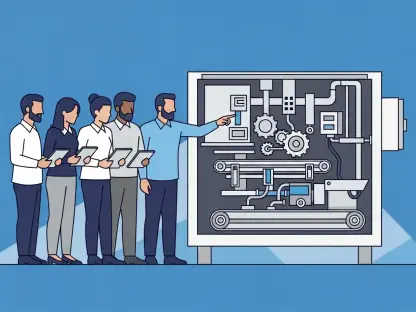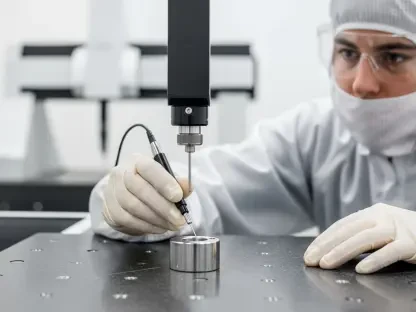In the heart of a bustling manufacturing plant, a line supervisor squints at a tablet, skeptical about yet another “game-changing” tool promised by management, a scene that plays out daily across countless facilities in 2025. Digital transformation is no longer just a buzzword but a pressing reality in these environments. Despite billions invested globally, nearly 70% of these initiatives fail to deliver expected results. The culprit isn’t the technology—it’s the people on the shop floor who must adopt it. What if the secret to success lies not in coding or hardware, but in mastering the art of persuasion right where the machines hum?
Why Digital Transformation Mimics a Sales Pitch
At its core, rolling out digital tools in manufacturing resembles a high-stakes sales job. The product isn’t just software or sensors; it’s a vision of efficiency and innovation that must be bought by the very teams who will use it. Shop floor workers—technicians, operators, and leads—aren’t passive recipients. They are discerning customers who need convincing that this change will benefit their daily grind.
The challenge lies in translating executive strategy into tangible value for those on the ground. A shiny new system means little if it disrupts established routines or adds complexity without clear payoff. Success hinges on operations leaders stepping into the role of salespeople, pitching not just features, but a better way of working that resonates with the floor’s priorities.
The Core Obstacle: Human Resistance Over Tech Glitches
While technology often takes the spotlight in transformation talks, data reveals a different story. Research indicates that human factors, like resistance to change and lack of engagement, derail most projects, far more than technical failures. For shop floor teams, a new digital system isn’t a distant corporate goal—it’s a direct alteration to their workflow, sometimes perceived as a threat to their expertise.
This disconnect between boardroom vision and factory floor reality creates friction. Workers might question why they should abandon familiar methods for unproven tools, especially when communication from leadership feels detached. Bridging this gap requires acknowledging these personal stakes and addressing them head-on, ensuring the human element isn’t an afterthought in the rush to digitize.
Turning Tech Rollouts into Internal Sales Campaigns
To make digital transformation stick, it must be framed as an internal sales pitch tailored to the shop floor. Start by viewing employees as customers whose needs must be met. Explain the tool’s purpose in plain terms and offer hands-on demos to showcase immediate benefits, like slashing downtime with a single click.
Next, align the pitch with what matters most to these teams—less chaos, faster repairs, and balanced workloads. Highlight how the change eases specific pain points, such as reducing late shifts caused by inefficiencies. Avoid generic promises; instead, pinpoint how the tech improves their unique tasks.
Finally, prioritize action over words. Move beyond PowerPoint slides and demonstrate the system live on the floor—create a work order instantly or display real-time equipment data. These vivid, practical examples leave a lasting impression, building trust and proving the tool’s worth in a way abstract concepts cannot.
Lessons from the Trenches: Real-World Impact
Insights from industry leaders underscore the power of a people-first approach. Nick Haase, co-founder of MaintainX, notes that “the most successful transformations are driven by the best internal sales efforts.” His experience with thousands of manufacturing firms reveals a compelling case from a Midwestern auto supplier, where a maintenance supervisor turned skepticism into support by addressing a relatable issue.
During a rollout, the supervisor shared a story of a technician missing a family event while hunting for a machine spec. By demonstrating a digital solution that provided instant access to checklists and live updates, the team saw repeat faults decrease and compliance improve within weeks. This human-centered narrative, backed by visible results, proved more persuasive than any corporate report.
Supporting this, industry studies show that manufacturers emphasizing cultural change alongside tech adoption achieve up to 30% higher returns on investment. When workers connect emotionally and practically to the change, the numbers follow, proving that stories and proof points are critical tools in this internal sale.
Actionable Tactics to Secure Shop Floor Buy-In
Winning over the shop floor demands a strategic playbook grounded in small, measurable steps. Begin with a focused pilot—target a single line or asset, tracking clear metrics like reduced downtime or faster job closures. Display progress on a visible scoreboard to spark curiosity and momentum among the wider team.
Anticipate pushback and prepare for it as any skilled salesperson would. Concerns like “this takes too much time” can be countered with quick wins—run a brief trial with minimal disruption or show how a photo upload prevents future errors without extra effort. Validate every objection, then address it with evidence from the floor, not just assurances from above.
Lastly, foster collaboration rather than issuing mandates. Engage teams as partners by involving them in testing phases and celebrating early successes together. Highlight how the tool fits into their real operations, ensuring they see themselves as co-creators of the change. This gradual, inclusive approach transforms reluctance into ownership, securing lasting adoption.
Reflecting on a Persuasive Path Forward
Looking back, the journey of digital transformation in manufacturing revealed a profound truth: technology alone couldn’t carry the day. It was the art of persuasion, the ability to sell a vision to the shop floor, that determined whether initiatives flourished or faltered. Each story shared, each demo conducted, built a bridge over skepticism.
Moving ahead, the focus should shift to equipping leaders with the tools to pitch effectively—training them not just in tech, but in empathy and communication. Prioritizing pilot programs with transparent results can further solidify trust. As plants continue to evolve, the lesson remains clear: treat the floor as valued customers, and the path to a digital future becomes not just possible, but enthusiastically embraced.









